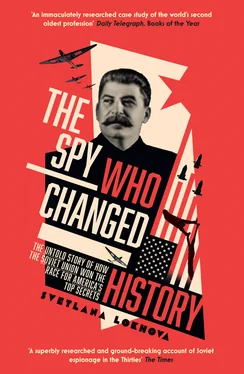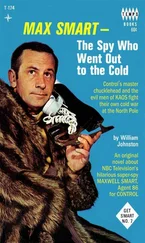Because of the foreign exchange difficulties and unacceptable conditions for loans in America, I demand an end to all business contracts with the United States. Instead we must seek every opportunity to break existing agreements. In the future all orders will be placed with European or Soviet factories, making no exceptions, even for the most important construction projects. 10
The world’s first Communist state had spent so heavily in the first stage of the investment plan that it had run out of money and credit. Turning the Soviet Union from a country of peasants with wooden ploughs into a modern industrial society was proving prohibitively expensive. Despite Stalin’s exploitation to the full of American commercial terms, he now needed to rely on industrial espionage. The Soviets pressed on with their plans, but with no cash to pay engineers from abroad, they were required to use their own experts, helped by the information provided by their intelligence gathering abroad.
Until the money ran out, every large Soviet enterprise built in this period received most of its equipment from American or European engineering companies. As diplomatic relations between the US and the USSR improved, the floodgates had opened to facilitate the transfer of skills and technology to Russia. All Soviet commercial activities in the United States were overseen by its single agency, the American Trading Corporation or AMTORG, established in 1924 with offices on New York’s Fifth Avenue, in Moscow and eventually in several other cities in the USSR and the USA. Although nominally independent of the state, which was a requirement if it were to obtain legal status to trade in the United States, it was the sole Soviet reseller as well as being tasked with providing information on all aspects of US business. All commercial deals and contracts with American firms, experts, and payment for their services went via AMTORG. It would develop a well-deserved reputation as a veritable nest of spies, its employees under constant US counter-intelligence surveillance.
• • •
The Five-Year Plans had three interrelated goals: to build an industrialised society, to create an educated population, and to ensure that the Soviet Union had the means to defend itself in the event of an attack. Stalin spoke of the imperative to modernise the Soviet economy as fast as possible to meet the imminent imperialist threat. A substantial challenge for Stalin’s Russia was how to protect its vast land borders and natural resources. After invasions from the Polish King Stephen Báthory, fn1the Swedish King Gustav Adolphus, fn2the French Emperor Napoleon fn3and the German Kaiser, followed by the Allied intervention, the lesson of history was that the Soviet army must be equipped with the most up-to-date weapons to deter further invaders. Dzerzhinsky had analysed the Tsar’s defeat. Iron Felix’s assessment of Russia’s performance in the Great War was strikingly similar to that of the current Russian foreign intelligence service, the SVR (Sluzhba Vneshney Razvedki), whose official history mocks the naivety of the Tsarist government in embarking on a modern war without the technical resources to equip its armed forces. 11Dzerzhinsky’s studies for the Supreme Economic Council in 1924–5 emphasised that the reason for defeat lay in the dependence of the Tsarist war effort on imports of arms and munitions from its Western allies. In 1914, Russia could not even manufacture sufficient rifles for its army. It was not until 1916, thanks largely to British finance and US industrial expertise, that Russia developed a somewhat more adequate munitions industry. The Western allies had rescued the wartime Tsarist arms industry for their own war aims but were unlikely to help Communist Russia. Like defeated Germany, the Soviet Union was treated as a pariah state.
The British Empire was seen as the likely enemy. Stalin was privately convinced, as Dzerzhinsky had been, that the modernisation of the Soviet defence industry also required S&T from the West – first and foremost from the United States. And, since Stalin believed that war with the imperialist powers was inevitable, S&T was therefore a top priority. As he was to declare in February 1931 in a speech to industrial managers: ‘We are fifty or a hundred years behind the advanced countries. We must catch up in ten years. Either we do it, or they will crush us.’ 12Though he did not realise at the time who the most dangerous potential enemy would be, the forecast was to prove prophetic.
Given the urgency, Stalin turned to his intelligence service. His library gives an extraordinary glimpse into his thinking as he marked up the passages of his reading that he found most insightful. Stalin’s deep interest in developing S&T operations in the United States grew from a fascination with US and British writing on espionage. Dzerzhinsky’s death in 1926 seems to have slowed the development of S&T, but only for a short while. In 1929, the autodidactic Stalin devoured the informative book Spy and Counterspy: The Development of Modern Espionage by the US writer Richard Wilmer Rowan. 13Stalin’s copy survives in his archive, with notes scrawled in the margin. It was from this US book that he learned how to direct and organise intelligence-gathering operations. He was attracted to the idea of using spies, not least because, as Rowan argued, they were inexpensive and efficient. In Rowan he had found the solution to his problem of how to acquire the best technology without paying for it. But he needed extraordinary men and women to become his spies.

Stalin’s copy of the Russian translation of Rowan’s Spy and Counterspy – special edition for Soviet Military Intelligence. Stalin’s note says, ‘Abridged translation from English’
Shumovsky’s reports had highlighted the extensive problems of the armaments industry. Given the perceived threat, the country had to develop its industrial capability to sustain a prolonged fight. Without modern factories to manufacture arms, Russia remained vulnerable to a foreign invasion. Some modernisation of the armed forces was achieved thanks to secret Soviet-German military cooperation fn4during the 1920s, but not enough. Both Germany and Russia believed, correctly, that the other was spying on them. Their shared distrust of the well-armed buffer state of Poland did not provide enough common ground to make them real allies. Moreover, the Germans were concerned that the Moscow-based Comintern (Communist International) interfered, sometimes violently, in their domestic politics. The Soviets, on the other hand, were convinced by the evidence that they were only gaining access to obsolete German military equipment, not the latest and best. 14The issues were greatest in aviation. Dzerzhinsky highlighted to Stalin a joint venture to design and build aircraft with the German manufacturers Junkers in Moscow as a particular failure. The Soviet Union urgently needed a modern air force and Germany could not provide one. The United States, not Germany, Dzerzhinsky convinced Stalin, held the key to the future of the Soviet aircraft industry. But they also knew that only some American industrial expertise could be openly obtained through commercial contracts. In 1925, the Foreign Department (INO) of the NKVD adopted S&T operations as one of its objectives for the first time. 15The US aviation industry was one of the key targets. Shumovsky and his cohort were the men that Stalin would come to rely on to help fulfil his dreams to industrialise and defend his country.
• • •
Stalin’s Russia was the first country in the world to try to identify each year its ablest, most loyal workers to train as scientists and engineers. Some of these elite scientists and engineers would later become spies. As part of the Five-Year Plan launched in 1928, a thousand of the best and brightest young Communist Party members (the parttysiachniki ) were selected to receive the finest higher education on offer in Moscow and Leningrad. The Party had identified Shumovsky during his three years’ work at the Ministry of Finance as a potential future leader, a Party cadre. Already a qualified pilot, he was one of a very few selected to study aeronautics at the elite Bauman Institute, where his Professor of Aerodynamics was none other than Andrey Tupolev, Russia’s most famous aircraft designer. Teacher and pupil became fast friends. Towards the end of his course at the Bauman, Shumovsky was invited by the local Committee of the Communist Party to a meeting at the Lubyanka, the headquarters of the NKVD, that would once again change the course of his life. At this meeting, he met Stanislav Messing, the head of INO, and the legendary Artur Artuzov, then the deputy head.
Читать дальше













